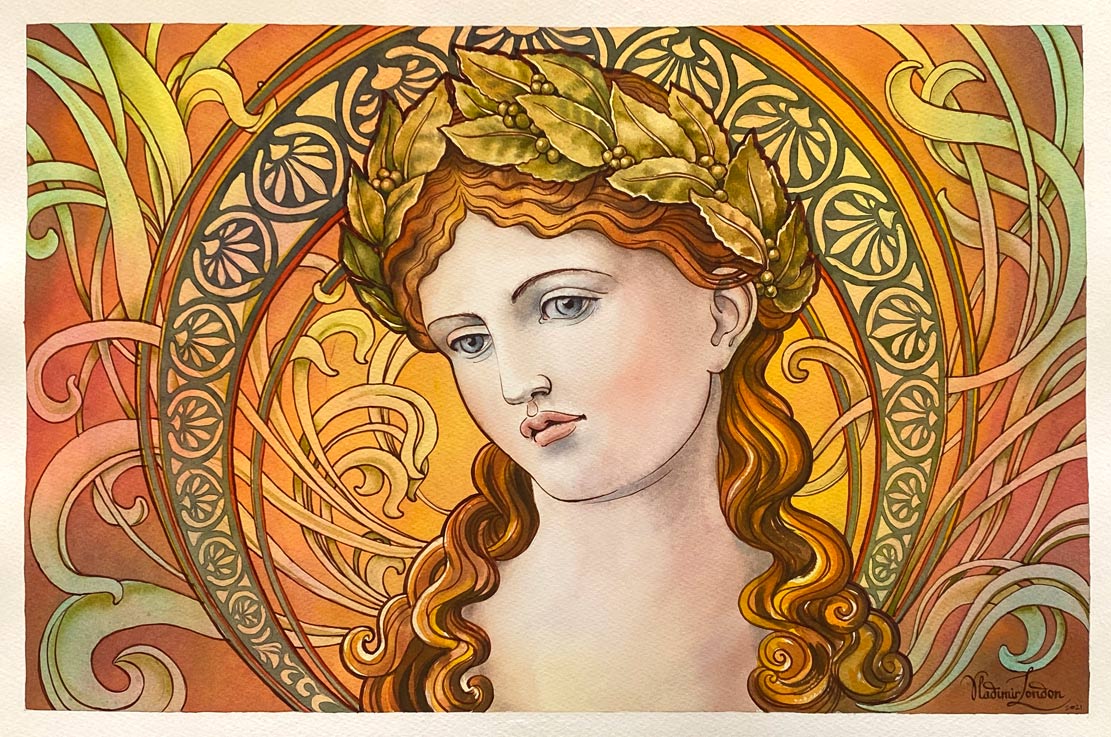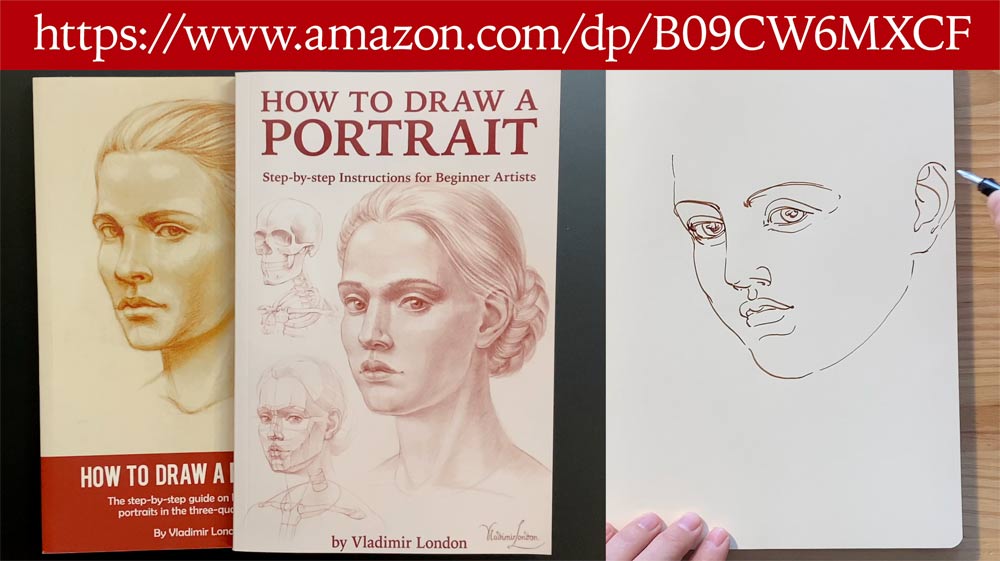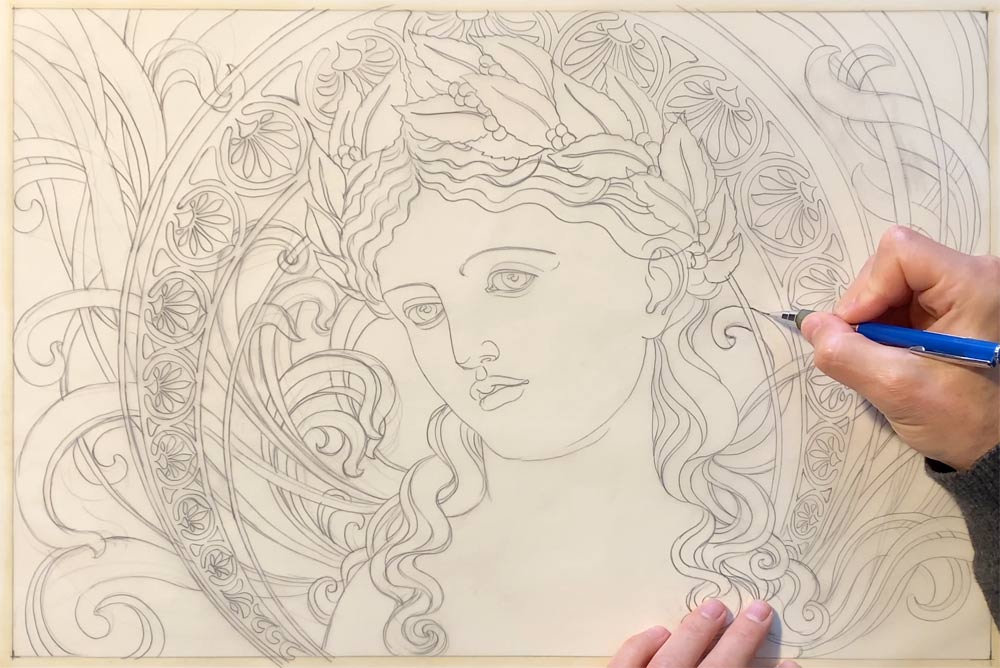A self-study, self-paced course where you can learn how to paint in watercolor by watching video lessons and doing assignments
$297 USD
ENROLL NOWA self-study, self-paced course where you can learn how to paint in watercolor by watching video lessons and doing assignments
$297 USD
ENROLL NOWOne-to-one, unlimited and custom-tailored to your skills and needs Personal Tutoring by the Watercolor Academy teachers
$997 USD
ENROLL NOWBy Vladimir London, Watercolor Academy tutor
Part 1 - How to Draw a Portrait and Transfer It Onto Watercolor Paper

In this video I will talk about drawing. Here is one of my sketchbooks. In this book you can see a few sketches. These are preliminary drawings for a watercolor composition I have in mind. I will make another sketch in pen and ink using a fountain pen and brown ink. Do not ask me what kind of art materials I use; it is not about materials but skills. The reason I am using pen and ink is because every line is clear and final. Pen and ink is an unforgiving medium. If you make a mistake, that's it, you have a mistake. It forces you to make better drawings and think about every single line you put on paper.
I'm drawing this portrait from imagination. In case you are wondering, there is no reference for it. I have done hundreds and hundreds of similar portrait sketches and I can easily make another one from memory without a model. If you would like to see those hundreds of portrait sketches, please check my video where I demonstrate my sketchbooks.
Good portrait drawing skills don't come overnight. You have to know human head proportions and anatomy, use the necessary constructive drawing principles, and, of course, be able to control your pen-work with precision. Professional artists draw not what they see, but what they know. This is especially important when you draw from memory or imagination. To draw a realistic portrait, you have to know many things. I described in depth the sequential drawing steps of making a portrait in my two books on "How To Draw A Portrait":
These books are available in both eBook and paperback formats on Amazon. In these books, every step of drawing a portrait is explained and illustrated.

Of course, one or two books are not enough to learn portrait drawing skills. That is why we created the whole video course, Life Drawing Academy, where you can learn how to draw portraits and figures from life, memory and imagination the professional way. In this course I explain all you need to know about portrait drawing, including human head proportions, its anatomy and construction, and give a good demonstration of how to do it step by step in multiple video lessons. You'll find this course particularly helpful. In this Academy there are two courses: the self-learn online course where you can watch video lessons on figurative drawing; and one of the best drawing courses in the world, the Life Drawing Academy Correspondence Course, where you can get unlimited personal tutoring. This course comes with one hundred drawing tasks. By doing these you will improve your drawing skills to an advanced level. In this course you will learn not only how to draw portraits but actually how to draw anything you think, see or imagine. This course is for artists who like to learn good drawing skills in a fast and easy way. Every single task will come with in-depth instructions and demonstrations so you will know exactly what to do and how.
I have completed this portrait and now I will do a few more sketches to think about the composition. To finish telling you about the Life Drawing Academy Personal Tutoring Course, I also need to mention that every single artwork you do in this course will be checked by the academy tutors. You will receive a full critique and we will point out your mistakes and you will know exactly how to fix them.
This personal tutoring course is truly unique, there are no other courses like this. Nowhere else will you get a personal curriculum that is tailored to your level of skills and takes into account your needs and goals.
If you would like to check what the Life Drawing Academy Online Course is about, you can watch free demo videos. The link to those videos is provided in the description below. This quick sketch I am making is just a concept idea for the composition. As such, it doesn't have to be a perfect drawing. It is about sketching an idea and I will draw it once again, the actual size, later on.
The girl's portrait is decorated with a rounded design. These circular shapes are rather decorative and later on I will fine tune the shapes. On both sides of this composition there are free-flowing floral elements, which I am sketching very roughly right now. Once again I will work on every shape with precision later on. For now, I just want to get a feeling of what this composition looks like and decide on the balance between the portrait and floral pattern.
I am now making another fast sketch to fine tune the decorative pattern. What I love about sketching in pen and ink is that every line contributes to the drawing. Don't get me wrong, I am not advocating this medium for sketching. It is very challenging because it requires good drawing skills. Fixing mistakes in ink is impossible because ink lines are not erasable. But for the same reason this medium fits my purpose very well. I don't want to spend time on erasing and fixing mistakes. And should I sketch in graphite pencil it would be very tempting to make it perfect and beautiful. That is why I only want to roughly and quickly do a preliminary sketch. For me, making sketches is a way of thinking and planning. The faster I do lines, without interrupting my thinking process on erasing and redrawing them, the better. That is why my preferred medium for sketching is pen and ink.
I am making free flowing organic lines just to get an idea how they can interlock with the circular pattern design. This is not the final sketch and it might take several attempts to finalise this design. I will decide the precise shapes of these curly lines later on. I will continue making several more sketches of the portrait and the organic pattern design before making a cartoon. Cartoon is the name of a preliminary drawing, which is done in actual size. This is such a drawing that I have made in graphite pencil on drawing paper. The purpose of this cartoon is different from sketching - it is the final composition that I have to make perfect. I erase and redraw graphite lines several times until I am fully happy with the design. Because this composition is rather complicated I don't want to work on it directly on the watercolor paper sheet. Instead, I will transfer the final drawing onto the watercolor paper later.
Now it's time to check if this composition has any golden proportions. All proportions were done by eye. Now, I am using the golden mean caliper to check if any lines coincide with the golden ratio. As you can see, there are several golden proportions present in this composition. This usually happens when an artwork looks balanced and pleasing. To answer your question, no you don't have to buy a golden mean caliper unless you want to. You can easily check golden proportions with a ruler. Now it's time to transfer this drawing onto the tracing paper. It is A2 sized tracing paper and I fix it to the back of the cartoon. As you can see, the tracing paper is fixed to the drawing paper with masking tape.
I will set up a light table to transfer the design. For this purpose I will use the lamp and the clear plastic board. The lamp is located under the board. On top of this board I place the cartoon, face side down, and the tracing paper is facing up.

You may notice that by placing the design face side down, I have a reverse image. The reason why I have to mirror the drawing is because I will later transfer all these lines of graphite pencil onto the watercolor paper, and, if I don't mirror this drawing, it will be done in reverse on the watercolor paper. There are other ways to transfer the drawing onto the watercolor paper. But for the purpose of this video, I will use tracing. As you have seen, drawing a portrait is not a challenge for me. If I could do it in pen and ink I could easily make a portrait directly on the watercolor paper sheet. However the rest of the design is rather elaborate. That's why I decided to sketch the composition first, then make a cartoon and transfer it onto the watercolor paper. When tracing the design I actually change it once again. As you can see the face is exactly the same but the organic flowing lines are totally different. I redraw them once again on the tracing paper. I will now transfer this design onto the watercolor paper sheet. I put the tracing paper on top of the watercolor paper sheet, and to make sure the margins are the same on all four sides, I use the ruler. You may notice that the girl's portrait is looking to the left hand side, which is how it was originally designed. This drawing is actually on the reverse side of the tracing paper. Graphite pencil marks are facing the watercolor paper sheet. I mark the four corners to outline the margins of this artwork. I do it in graphite pencil with the ruler. With all four borders in place, I can now fix the paper sheet to the board. For this I am using masking tape. I have to say that this method of fixing paper to the board is not my favourite. It is fast and easy though. Fixing paper with masking tape works well if you plan an alla prima artwork. However this is not what I have in mind for this illustration. I will do this artwork in multiple painting layers so the masking tape might get unstuck. In addition to the masking tape, I will also use masking fluid. I will apply it with a cheap, synthetic brush. This is to prevent water getting under the tape. You may notice that there is a very small gap between the masking tape and the pencil line. It is only about two millimetres wide and I fill it with masking fluid. The masking fluid is totally dry. I can place the tracing paper on top and fix it at one side with two pieces of masking tape. I do not fix the tracing paper on all four sides so I can lift one side at any time. All that is left is to repeat the entire drawing line by line in pen or pencil. It is a rather mechanical task. I only have to make sure that every single line is outlined once again. From time to time, I can lift the tracing paper up to check how the drawing is transferring. When the full design is transferred I can remove the tracing paper.
The drawing is done. In the next part I will show you how to paint this composition in watercolor.
A self-study, self-paced course where you can learn how to paint in watercolor by watching video lessons and doing assignments
One-time payment - Lifetime membership
$297 USD
One-to-one, unlimited and custom-tailored to your skills and needs Personal Tutoring by the Watercolor Academy teachers
One-time payment - Lifetime membership
$997 USD